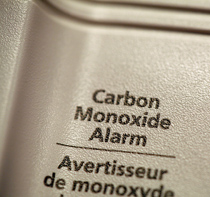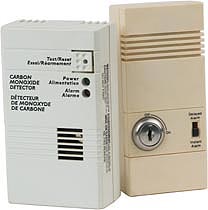-
(单词翻译:双击或拖选)
This is SCIENCE IN THE NEWS, in VOA Special English. I'm Bob Doughty1.
VOICE TWO:
 And I'm Faith Lapidus. Wintry conditions are returning to the northern part of the world. Winter brings cold weather and, with it, a danger as old as man's knowledge of fire. The danger is death or injury by carbon monoxide poisoning. Today, we tell about this ancient and continuing danger.
And I'm Faith Lapidus. Wintry conditions are returning to the northern part of the world. Winter brings cold weather and, with it, a danger as old as man's knowledge of fire. The danger is death or injury by carbon monoxide poisoning. Today, we tell about this ancient and continuing danger.(MUSIC)
VOICE ONE:
Several years ago, a family of five was enjoying a holiday in the American state of California, near the Pacific Ocean. The family included five children and their parents. The oldest child was twelve years old. The youngest was three.
The family was spending the weekend in a camper. A camper is a small shelter carried in the back of a truck. People can sleep in it for a few days.
The weather turned cold the second night the family stayed along the Pacific coast. The camper did not have any heating2 equipment to warm the space while family members slept.
VOICE TWO:
Someone decided3 to heat the area by placing a charcoal4 grill5 inside the camper. The device6 burned a wood product, charcoal. The fire immediately warmed the family members. They all went to sleep.
The next day, other people found the family. The parents and their five children had died in their sleep. They died because they did not know that burning wood products creates a deadly gas – carbon monoxide.
Carbon monoxide poisoning is known as a silent killer7. The California family went to sleep in their warm camper and never woke up.
(MUSIC)
VOICE ONE:
Carbon monoxide poisoning causes death and injuries around the world. The poison gas has been a problem since people first began burning fuels to cook food or to create heat.
This gas is a problem in all parts of the world that experience cold weather. Last year, America's Centers for Disease8 Control studied deaths linked to carbon monoxide poisoning. It found that the average number of carbon monoxide deaths in the United States is greatest in the month of January.
The study also found that carbon monoxide kills about five hundred people in the United States each year. And, the report said, about fifteen thousand people are taken to hospital emergency rooms for treatment of health problems linked to the gas.
VOICE TWO:
Carbon monoxide is called the silent killer because people do not know it is in the air. The gas has no color. It has no taste. It has no smell. It does not cause burning eyes. And it does not cause people to cough.
Yet carbon monoxide gas is very deadly. It steals the body's ability to use oxygen.
Carbon monoxide decreases the ability of the blood to carry oxygen to body tissues9. It does this by linking with the blood. When the gas links with the blood, the blood is no longer able to carry oxygen to the tissues that need it. Damage to the body can begin very quickly from large amounts of carbon monoxide.
How quickly this can happen depends on the length of time a person is breathing the gas and the amount of the gas he or she breathes in.
VOICE ONE:
Carbon monoxide poisoning has warning signs. But people have to be awake to recognize them. Small amounts of the gas will cause a person's head to hurt. He or she may begin to feel tired. The victim's stomach may feel sick. The room may appear to be turning around. The person may have trouble thinking clearly.
People develop severe head pain as the amount of gas continues to enter their blood. They will begin to feel very tired and sleepy. They may have terrible stomach pains.
VOICE TWO:
Carbon monoxide is measured in parts per million in a normal atmosphere. Breathing in two hundred parts per million of carbon monoxide will cause the first signs of poisoning. It will result in head pain, stomach problems and a feeling of tiredness after two to three hours.
A level of eight hundred parts per million will cause a person to lose consciousness10. Victims will not know what is taking place around them. This will happen within two hours of breathing in this amount of carbon monoxide. Twelve thousand parts per million of the gas will cause death in one to three minutes.
VOICE ONE:
Medical experts say carbon monoxide affects people differently. For example, a small child will experience health problems or die much quicker than an adult will. The general health of the person or his or her age can also be important.
An older adult with health problems may suffer the effects of carbon monoxide more quickly than a younger person with no health problems. People with heart disease may suffer chest pains. They may begin to have trouble breathing.
VOICE TWO:
Carbon monoxide does not always cause death. But it can cause many medical problems. Breathing low amounts of the gas for long periods of time can lead to permanent damage in the heart, lungs or brain.
Medical experts say small amounts of carbon monoxide over a long period of time can greatly harm an unborn baby.
(MUSIC)
VOICE ONE:
What causes carbon monoxide gas? Any device that burns fuels such as coal, oil or wood can create the gas.
Water heaters that burn natural gas create carbon monoxide. Fireplaces12 and stoves that burn wood create the gas. Natural gas stoves and gas dryers13 or charcoal grills14 also create carbon monoxide. Automobiles16 create it. Any device that burns fossil17 fuels like coal, oil, wood, gasoline18, kerosene19 or propane will produce carbon monoxide.
Experts agree that the leading cause of carbon monoxide poisoning is damaged equipment that burns these fuels. They say many people die or are injured by the gas because they do not use these devices20 correctly.
Experts say any device used to heat a home should be inspected to make sure it is working correctly. And, no cooking equipment like a charcoal grill should ever be used to heat an inside area.
VOICE TWO:
Carbon monoxide gas is created by fuel burning devices because not all of the fuel is burned. Most devices used for home heating have a way to expel21 the gas from the home. For example, a fireplace11 has a chimney22. Natural gas stoves or gas water heaters are usually connected to a device that safely expels23 the gas from the home. An automobile15 has a system for expelling24 unburned gasoline under and behind the vehicle.
Anyone who uses a device that burns fossil fuel must inspect the equipment carefully to reduce chances of carbon monoxide escaping. Companies that produce the devices usually provide directions about using the device correctly. These directions should be read and understood before using any equipment that burns fuel inside a home.
(MUSIC)
VOICE ONE:
You can do a number of things to protect yourself from the effects of carbon monoxide. First, immediately leave the area if you recognize the signs of carbon monoxide poisoning in yourself or others.
Seek emergency medical services after you leave the area where you suspect the gas might be. Usually the treatment for carbon monoxide poisoning involves breathing in large amounts of oxygen. However, a doctor will know the best method to treat the effects of such poisoning.
Carbon monoxide does not quickly leave the body, even after treatment has begun. It can take several hours before the gas disappears.
VOICE TWO:
If you suspect carbon monoxide is a problem in your home, you might try calling your local fire department. Many firefighters have the necessary equipment to find or identify the gas.
 |
| Carbon monoxide detectors25 |
In many countries, it is possible to buy and use a special device that will warn when harmful levels of carbon monoxide are in the area. These devices can be linked to a home's electric system. Others work with electric batteries. Experts say these special devices should be placed near sleeping areas in the home.
The most important weapon against carbon monoxide poisoning is the safe use of materials to heat any enclosed26 area. Safety directions that come with heating equipment must be followed. Older fossil fuel burning heating equipment should be inspected every year to make sure it continues to be safe. Knowledge about the dangers of carbon monoxide could be the most important information you ever learn.
(MUSIC)
VOICE ONE:
This SCIENCE IN THE NEWS was written by Nancy Steinbach. Our producer was Brianna Blake. I'm Bob Doughty.
VOICE TWO:
And I'm Faith Lapidus. Read and listen to our programs at voaspecialenglish.com. Join us again next week for more news about science in Special English on the Voice of America.
 收听单词发音
收听单词发音
1
doughty

|
|
| adj.勇猛的,坚强的 | |
参考例句: |
|
|
|
2
heating

|
|
| n.加热,供暖,暖气装置;adj.加热的,供暖的 | |
参考例句: |
|
|
|
3
decided

|
|
| adj.决定了的,坚决的;明显的,明确的 | |
参考例句: |
|
|
|
4
charcoal

|
|
| n.炭,木炭,生物炭 | |
参考例句: |
|
|
|
5
grill

|
|
| n.烤架,铁格子,烤肉;v.烧,烤,严加盘问 | |
参考例句: |
|
|
|
6
device

|
|
| n.器械,装置;计划,策略,诡计 | |
参考例句: |
|
|
|
7
killer

|
|
| n.杀人者,杀人犯,杀手,屠杀者 | |
参考例句: |
|
|
|
8
disease

|
|
| n.疾病,弊端 | |
参考例句: |
|
|
|
9
tissues

|
|
| n.组织( tissue的名词复数 );薄纸;棉纸;一套 | |
参考例句: |
|
|
|
10
consciousness

|
|
| n.意识,觉悟,知觉 | |
参考例句: |
|
|
|
11
fireplace

|
|
| n.壁炉,炉灶 | |
参考例句: |
|
|
|
12
fireplaces

|
|
| 壁炉( fireplace的名词复数 ) | |
参考例句: |
|
|
|
13
dryers

|
|
| n.干燥机( dryer的名词复数 );干燥器;干燥剂;干燥工 | |
参考例句: |
|
|
|
14
grills

|
|
| n.烤架( grill的名词复数 );(一盘)烤肉;格板;烧烤餐馆v.烧烤( grill的第三人称单数 );拷问,盘问 | |
参考例句: |
|
|
|
15
automobile

|
|
| n.汽车,机动车 | |
参考例句: |
|
|
|
16
automobiles

|
|
| n.汽车( automobile的名词复数 ) | |
参考例句: |
|
|
|
17
fossil

|
|
| n.化石,食古不化的人,老顽固 | |
参考例句: |
|
|
|
18
gasoline

|
|
| n.(美)汽油 | |
参考例句: |
|
|
|
19
kerosene

|
|
| n.(kerosine)煤油,火油 | |
参考例句: |
|
|
|
20
devices

|
|
| n.设备;装置( device的名词复数 );花招;(为实现某种目的的)计划;手段 | |
参考例句: |
|
|
|
21
expel

|
|
| vt.把...开除,驱逐,放逐,排出,喷出 | |
参考例句: |
|
|
|
22
chimney

|
|
| n.烟囱,烟筒;玻璃罩 | |
参考例句: |
|
|
|
23
expels

|
|
| 驱逐( expel的第三人称单数 ); 赶走; 把…除名; 排出 | |
参考例句: |
|
|
|
24
expelling

|
|
| 驱逐( expel的现在分词 ); 赶走; 把…除名; 排出 | |
参考例句: |
|
|
|
25
detectors

|
|
| 探测器( detector的名词复数 ) | |
参考例句: |
|
|
|
26
enclosed

|
|
| adj.被附上的;(用墙等)围住的;封闭的;与外界隔绝的v.(用墙、篱笆等)把…围起来( enclose的过去式和过去分词 );把…装入信封;附入;(尤指墙、篱笆等 )围住 | |
参考例句: |
|
|
|

















